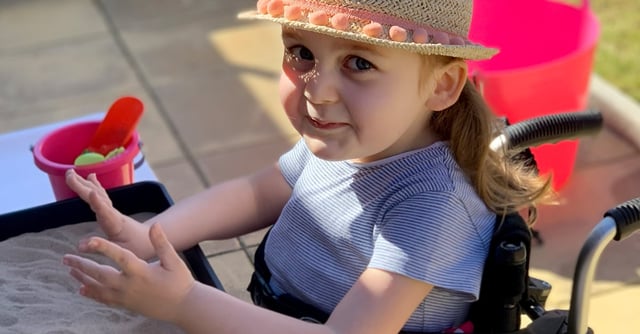
Nov 6, 2020Meet Sophia - a charming 5-year-old

Back to Blog Overview
Sophia is a charming little 5-year-old girl with a big personality. “She’s exceptionally smart and difficult to argue with; she’s stubborn, but I also think that all those attributes make her quite a fighter which she needs to be able to deal with everyday doses of reality and SMA” – her father tells us.
She loves playing, and one of her favourites is imaginative play where she’s directing the actors of the play. During the Covid-19 shielding this happens to be her parents. The scenes are developed through a combination of her imagination and things she has seen. Roles are assigned to the actors, and at the moment she’s inspired by Harry Potter. She asks her father to be Lucius Malfoy and her mother Bellatrix Lestrange and she herself is little Lord Voldemort!
She often chooses those dark-side characters who are different, who stand out. Maybe she in some way identifies herself with them because they are “different” and she’s totally aware that she’s different too, her father says.
He tells us that every day they have a “Love bombing hour" where they set aside everything else and are simply together, playing and having fun! It’s during these times an imaginative play is often carried out.
When Sophia was diagnosed with SMA
The parents observed a delayed motor development at an early stage of Sophia’s life, and when realising that she wasn’t able to sit at an age where this is expected, they consulted a doctor with their concern. Sophia went through all necessary examinations and was finally diagnosed with SMA type 1 in April 2016, just before she turned one. At this point the parents didn’t know anything about SMA.
Read more: What is SMA?
It was of course emotionally challenging to understand the seriousness of such a diagnosis, and the whole extended family was affected by the situation and the uncertainty of what the future would bring.
Sophia’s father tells us that he used to have this quote burned into his head: “Take her home – Love her – but don’t get used to her”, because back in 2016, children with SMA type 1 had a life expectancy of 2 years old.
A new opportunity
The parents wanted to do all that was possible for Sophia and found that the new medication Spinraza was an opportunity. Unfortunately, this treatment was currently not available in the UK! Due to the severity of Sophia’s diagnosis they were completely sure that they couldn’t let time pass by and not give her the chance of this new treatment. In February 2017 they travelled to Paris to let Sophia have her first dose with Spinraza, and after 4 loading doses in France, she continued this treatment at the Great Ormond Street Hospital in London. She has been treated with Spinraza ever since, every 4 months, which is the standard dose prescription.
Regaining motor function
The effects they identified from the treatment was that certain functional movements Sophia lost at the very beginning, where the very movements she began to regain. Her head control wasn’t existing before, but now head control is pretty good. Movement of the arms was limited, however, now she can pick up a glass and have a drink of water, wash her face, and clap her hands. This makes her more independent when it comes to activities of daily living. She can eat by herself and participate in play and school activities, like writing. She has recently developed the ability to self-propel a manual wheelchair, which is a huge achievement for her!
She can now push a pen towards a piece of paper and write her name; a year ago that was not possible.
Fatigue is a well known side effect of SMA, but her parents observe that this has decreased over the last couple of years.
This has a great impact on her daily living because Sophia is now able to participate in many more tasks on her own without being completely exhausted.
The Innowalk as a tool for movement
Sophia and her parents were introduced to the Innowalk for the first time at Kids Physio London, which is a private paediatric physiotherapy clinic. Sophia trailed the device, and her parents were convinced that this was a piece of equipment they wanted Sophia to have to encourage repetitive movement in standing with weightbearing.
At this time Sophia was 3 years old and had been treated with Spinraza for one year.
My first impression was that the Innowalk was an interesting piece of equipment letting Sophia engage with her muscles that she didn’t necessarily know exist.
The family managed to raise the funding for the Innowalk and have used it ever since. Sophia has improved her standing position tremendously in this period, from standing with some flexion in her knees to now being in an almost fully upright position. When she works out in the Innowalk she usually has a “warming-up” session first and then continues with a “push and pull” period. This means she’s working on pushing down her feet during the stance phase and pulling up during the swing phase. Her parents see and hear on the motor that she has gained force and is now contributing more and more in the movement.
She uses the Innowalk every second day, but duration is continuously adapted to daily capacity.
Spinraza has an effect on the muscles, but to improve muscle function, the muscles need to be used. That’s why training with the physiotherapist, and the use of Innowalk and other assistive devices, in combination with Spinraza, is so important.
As Sophia’s father says: “SMA has a spectrum of people varying in function, and the response to treatment will differ. Treatment start, related to age of course, also plays a role in what you can expect as a response to the medication”.
Sophia continues to have improvements. For some it might look like small steps, but for her parents it’s life changing moments to see Sophia develop. “We don’t know what the limit is for what Sophia can achieve”, her father says.
Recently Sophia’s school class had the “Walk a mile” challenge, walking around the football field. Sophia has done a mile in her wheelchair, but we wanted to see if she could walk a mile in the Innowalk, and she made it. During a two-week period, she managed to walk a mile. “We are so proud of her achievement”, her father tells.
The future
The family feels positive about Sophia’s future, and they are giving her all possible opportunities to be able to explore the world around her. They will keep on working together with other people with SMA, their friends and families to make the best treatment available for people with SMA. They believe in working and fighting together so their voice and needs are not just heard but met. The charity organisation TreatSMA, that Sophia’s father is engaged in, has played a huge role in representing and supporting people and their families with SMA.
TreatSMA
is a UK charity run by people living with SMA and their parents and carers. It was founded in 2017 and the aim of the charity is to improve the diagnostics, standard of care, social support, and access to treatment, for people with SMA. They do a lot of activities for families which now due to Covid-19 are mostly digital, like webinars. We encourage you to follow them on Facebook and engage in their work.
When Sophia was diagnosed with such a serious disease, her parents expressed feeling emotionally shattered and do not deny the post traumatic stress that came with it. Realising that fear is a feeling they must learn to live with. “We can’t control the outside world and Sophia’s life is hugely dependant on for example the production and supply of the right medication, which is at the moment is Spinraza” her father tell and continues “However, we will always fight for our daughter and ensure we give her the absolute best treatment available at any times”.

Rikke Damkjær Moen brings many years of experience as clinical physiotherapist to the Made for Movement team. Her mission is to ensure that everybody, regardless of mobility problems, should be able to experience the joy and health benefits of physical activity. As our Medical Manager, Rikke is passionate about sharing knowledge so that individuals with special needs, families, and clinicians can discover the possibilities and solutions provided by Made for Movement.


